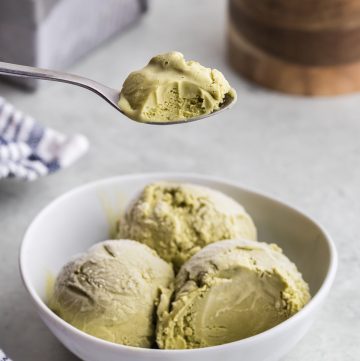
Matcha Ice Cream
Many might assume green tea ice cream to be bland, but its flavor is surprisingly complex. It strikes a perfect balance between the sweet creaminess of ice cream and the deep, earthy richness of matcha, accented by grassy undertones and a subtle bittersweetness - like a matcha latte in frozen form.
Ingredients
- 2/3 cup granulated sugar
- 4 egg yolks
- 1 1/2 cup whole milk
- 2 1/2 tablespoon matcha powder
- 1 1/2 cup heavy cream
Instructions
- In a medium sized mixing bowl, combine the egg yolks and sugar. Using a whisk or hand blender cream together the yolks and sugar until you have a pale yellow thick liquid.
- In another small mixing bowl make the matcha paste. Matcha will clump if you just add it directly to a large volume of liquid. So begin with your matcha powder in the mixing bowl and add a small amount of the whole milk to it, about 2 tablespoons. Use a fork to begin combining the milk and matcha powder and keep adding a tablespoon or two of milk at a time with mixing in between until you get a creamy paste with few to no clumps.
- Transfer the matcha paste to a medium sized saucepan. Add the remaining whole milk (but don't add the heavy cream - keep it in the fridge) and use a whisk to completely combine the matcha paste and the milk. Place on the stovetop and begin heating on medium heat until the matcha milk is hot but not boiling around 170F (you might see steam being released).
- Remove roughly a half cup of the hot matcha milk and set the saucepan aside.
- Return to the mixing bowl with the egg yolk and sugar mixture. Begin adding the 1/2 cup of hot matcha milk slowly with constant stirring (can use a whisk or a spoon). This will temper the eggs.
- Slowly add the tempered egg/matcha/milk mixture to the rest of the hot matcha milk in the saucepan while stirring constantly. Once fully combined, turn the heat up to medium and begin heating with constant stirring until the temperature reaches about 170F, try to stay under 175F. See Note 4. You may notice the mixture begins to thicken, but you don't want it to boil. This is now your custard base.
- Remove the saucepan from the heat and pour it through a fine mesh sieve into a clean mixing bowl. You may need to use a rubber spatula to help push the custard through the sieve. If you don't have a fine mesh sieve, you can skip this step, you might just have a few lumps in your final ice cream.
- Add your cold heavy cream to the strained matcha custard and stir to completely combine. Cover the matcha custard with a lid or saran wrap and place in the fridge to cool for at least 4 hours or overnight. It is important to let the custard cool completely. Adding warm or slightly warm ice cream batter to your ice cream maker may leave you with a "liquidy" final product if the cold temperature from your ice cream maker isn't enough to overcome the temperature of your custard.
- Once your ice cream batter has cooled to fridge temperature you can follow the instructions of your ice cream manufacturer. For my KitchenAid mixer I need to make sure the mixer is turning before I add in the ice cream batter or it may freeze solid and break the mixer when you turn it on.
- Let the ice cream churn in the ice cream maker for 22 minutes. Scoop out the ice cream (it will have the consistency of soft serve at this point) and place in a container that is freezer safe. Smooth out the surface with gentle pressing in order to remove any air pockets then cover and place in the freezer for at least 7 hours to get a firmer consistency suitable for scooping.
- Once fully chilled, you can scoop and serve in a cone or a bowl.
Notes
- Make sure to put the ice cream maker bowl in the freezer at least 16 hours before you will need it. Nothing worse than getting to the ice cream making step and not having your bowl ready.
- I leave the heavy cream in the fridge and add it to the warm custard base to help cool the custard down faster. Many recipes add the heavy cream when the whole milk is added and heat on the stovetop…
- Matcha powder is such a fine powder that it has electrostatic forces that cause it to clump when you are trying to mix it into water. Also, matcha will never actually dissolve in water, at best you are able to evenly disperse it. This is why it is good to make a paste by slowly adding water and whisking together.
- Matcha is also heat sensitive. Normally when making matcha tea you use water that is below 175F. If you go over this, the matcha can become more bitter than you might hope for. So when heating up the milk and matcha, it is best to not go over 175F for the same reason.
- When shopping for matcha you can find "ceremonial grade" and "culinary grade". Ceremonial grade is more expensive and normally reserved for drinking on it's own, and culinary grade is for adding to recipes. I used culinary grade in this recipe with great results.